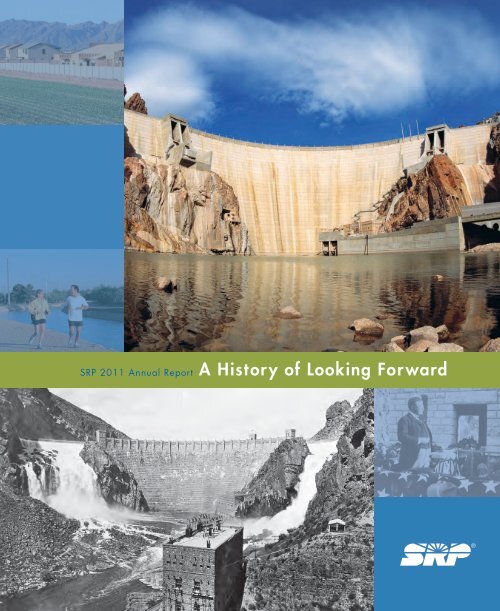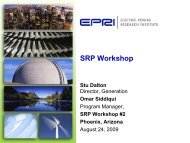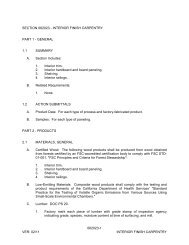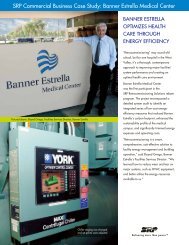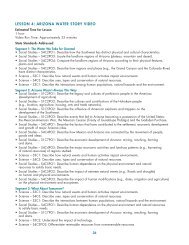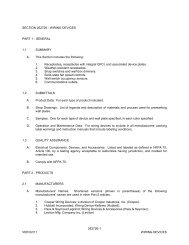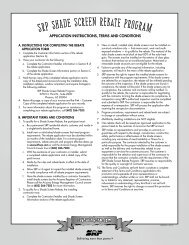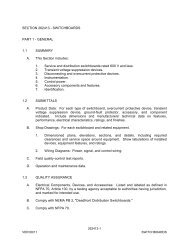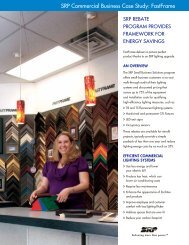A History of Looking Forward - Salt River Project
A History of Looking Forward - Salt River Project
A History of Looking Forward - Salt River Project
- No tags were found...
You also want an ePaper? Increase the reach of your titles
YUMPU automatically turns print PDFs into web optimized ePapers that Google loves.
SRP 2011 Annual ReportA <strong>History</strong> <strong>of</strong> <strong>Looking</strong> <strong>Forward</strong>
A <strong>History</strong> <strong>of</strong> <strong>Looking</strong> <strong>Forward</strong>About SRPSRP (<strong>Salt</strong> <strong>River</strong> <strong>Project</strong>) provides reliable, fairly pricedelectricity and water to more than 2 million people livingin central Arizona.As one <strong>of</strong> the nation’s largest public power utilities, weprovide generation, transmission and distribution servicesto homes and businesses in our 2,900-square-mile servicearea known as the Valley. We also are the area’s largestraw-water supplier, with a service area covering morethan 375 square miles and management responsibilitiesfor a 13,000-square-mile watershed.For more than a century, SRP has demonstrated foresightin providing the essential resources to meet the needs <strong>of</strong>our power customers and water shareholders and to helpthe Valley grow into one <strong>of</strong> the most vibrant metropolitanareas in the country.
CONTENTSLETTER TO ELECTRIC CUSTOMERS, WATER SHAREHOLDERSAND BONDHOLDERS........................................................ 2LETTER FROM THE GENERAL MANAGER........................................................ 4POWER SUPPLY........................................................ 6WATER STEWARDSHIP........................................................ 8SUSTAINABILITY........................................................ 10CUSTOMER COMMITMENT........................................................ 12COMMUNITY SERVICE........................................................ 14MANAGEMENT’S FINANCIAL AND OPERATIONAL SUMMARY........................................................ 16SRP BOARDS AND COUNCILS........................................................ 20CORPORATE INFORMATION........................................................ 22FIVE-YEAR OPERATIONAL AND STATISTICAL REVIEW........................................................ 23CONNECT WITH US ONLINE........................................................ 24
LETTER TO ELECTRIC CUSTOMERS,WATER SHAREHOLDERS AND BONDHOLDERS A <strong>History</strong> <strong>of</strong> <strong>Looking</strong> <strong>Forward</strong>David RousseauPresident— economic development and urbanization may never haveoccurred.SRP’s shareholders have some <strong>of</strong> the most senior water rights onthe watershed <strong>of</strong> the <strong>Salt</strong> and Verde rivers. Water certainty beginswith the protection <strong>of</strong> those rights.SRP’s legacy reaches back more than 100 years to earlypioneers who braved the rugged territory <strong>of</strong> Arizona, alternatelyfighting floods and droughts to forge their livelihoods inagriculture and plant the seeds for a future thriving metropolis.Our ancestors were among those visionary pioneers whochampioned the need for Theodore Roosevelt Dam, pledgingtheir land as collateral for federal loans that would build thedam and create water security for the Valley. They and othersjoined former President Theodore Roosevelt that spring day in1911 as the dam was dedicated for the benefit <strong>of</strong> generations <strong>of</strong>Arizonans that followed.That’s why this year’s Roosevelt Dam centennial was such asignificant occasion to celebrate.Without the dam, our Valley would look much different today.Roosevelt Lake, SRP’s largest reservoir, is our single mostimportant source <strong>of</strong> surface water. Without water certainty— a central element in SRP’s water resource managementThis year Congress approved the White Mountain Apache TribeWater Rights Quantification Act, which quantifies the tribe’sallocation and provides federal funding for new water storage anddelivery infrastructure. SRP played a major role in reaching thesettlement, thereby protecting the water rights <strong>of</strong> our shareholders.“Water certainty beginswith the protection <strong>of</strong> SRPshareholder water rights onthe watershed <strong>of</strong> the <strong>Salt</strong> andVerde rivers.”Today we deliver water and power to one <strong>of</strong> the nation’s largesturban areas, one with an increasingly diverse economy thatincludes manufacturing, technology, bioscience, finance andtourism, along with the agriculture that started it all. Even thoughthe Great Recession has taken its toll on Arizona, we believe we2SRP 2011 ANNUAL REPORT
will rebound with even more opportunities. As a provider <strong>of</strong>critical infrastructure, SRP accepts its pivotal role in that effort.During this recovery period, while population growth is slow, ourcustomers are conserving more and practicing energy-efficiencymeasures. For SRP, this translates to less need for costly electricsystem expansion, giving us time to focus on fresh solutions tochallenges facing the energy industry.“SRP is resolved to addreliable sources <strong>of</strong> sustainableenergy for the lowest cost toour customers.”Among those challenges is how to speed the integration <strong>of</strong>prudent sustainable energy resources. This year, the SRP Board <strong>of</strong>Directors asked management to closely examine its commitmentto this goal and make recommendations. Customers and otherstakeholders participated in a series <strong>of</strong> public workshops to helpus determine how to proceed.SRP is resolved to add reliable sources <strong>of</strong> sustainable energyfor the lowest cost to our customers.Sustainable resources will be managed to ensure gradualism(smoothing the impacts <strong>of</strong> cost movements), cost relation(establishing prices based on relationships to costs), equity(treating all types <strong>of</strong> customers fairly) and sufficiency (ensuringSRP’s financial well-being). The fiscal year 2012 (FY12) budgetincludes $100 million for additional sustainable resources.We will remain anchored in our heritage. Just as those before usmade the commitment to build Roosevelt Dam, SRP is committedto providing the Valley with a reliable supply <strong>of</strong> water and power.We and the other elected leaders <strong>of</strong> SRP will continue to work withmanagement to provide resource stewardship for the next100 years.SRP’s success can continue thanks to a diverse SRP workforce <strong>of</strong>innovative, hardworking thinkers committed to new ideas whilestaying true to our customers, shareholders and the communitieswe serve.As a result <strong>of</strong> the public and management review, the Board votedto adjust our goals to make them more aggressive and focused.We are now committed to providing 20% <strong>of</strong> retail requirementsfrom sustainable resources by 2020.John R. HoopesVice PresidentSRP 2011 ANNUAL REPORT3
LETTER FROM THE GENERAL MANAGER A <strong>History</strong> <strong>of</strong> <strong>Looking</strong> <strong>Forward</strong>Thanks to the leadership and example <strong>of</strong> my predecessor,Richard Silverman, I am fortunate to begin my time as SRPGeneral Manager leading a stable yet adaptable organization.SRP has a history <strong>of</strong> looking forward, and that’s a conceptI plan to embrace leading an integrated water and power utilitydedicated to serving the needs <strong>of</strong> our power customers andwater shareholders.Despite continuing challenges brought about by an uncertaineconomy, SRP had a good year.After 45 years with SRP, the last 17½ years as GeneralManager, this is my last annual report letter. The SRP Boardshave appointed Mark Bonsall, SRP’s longtime Associate GeneralManager and Chief Financial Executive, and a 33-year veteran<strong>of</strong> SRP, as the new General Manager.As I retire in August 2011, SRP management is in good hands.The new General Manager has announced his organizationand in the adjacent columns sets forth his vision and plans. Thetransition has gone smoothly and is welcomed by our industry,by our electric customers and water shareholders, and by ouremployees. While there is never a perfect time for a transitionin leadership, the current economy does present a window <strong>of</strong>opportunity to reflect, retool and redirect.I wish to thank both the SRP employees who have made theorganization successful and the many SRP elected <strong>of</strong>ficials, pastand present, who have supported management during my timeas General Manager. It has been an honor and a pleasure toserve, and I wish you well.Richard H. SilvermanA modest price increase coupled with cost-saving measures inplace throughout the fiscal year delivered positive financial results.SRP’s net revenues for the fiscal year ended April 30, 2011, totaled$304.6 million, compared with $371 million for the previous year.Operating revenues were $2.8 billion for FY11, compared with$2.7 billion for FY10.On March 18, we celebrated the 100-year anniversary <strong>of</strong>Theodore Roosevelt Dam, the cornerstone <strong>of</strong> SRP. Federal andstate leaders recognized the dam for the significant role it playedin the development <strong>of</strong> Arizona.“SRP, as a provider andsteward <strong>of</strong> the resourcesrequired for economicdevelopment, must take amore active role.”Our power system, especially the new generating unit atSpringerville, performed well. We added new control equipmentat two other power plants that results in significant air-qualityimprovements. Renewable energy efforts, including new wind andsolar projects, gained momentum.With the assistance <strong>of</strong> federal stimulus funds, we acceleratedthe installation <strong>of</strong> smart meters, which give more customers priceoptions that help shape electric load, while providing them withvaluable tools to manage their energy use.4SRP 2011 ANNUAL REPORT
Another major challenge before us is to balance the energy needs<strong>of</strong> our customers with the economic and environmental implications<strong>of</strong> available resources.We see a larger role for wind power in our Sustainable Portfolio.Locations near existing transmission lines help make it economicallyfeasible to use wind to generate electricity. We proved Arizona windwas a viable resource with the Dry Lake Wind Power <strong>Project</strong>, whichdoubled in size this fiscal year.Employees continued their impressive record <strong>of</strong> working safely andproviding some <strong>of</strong> the greatest customer service in the utility industry.And through SRP contributions and our employee volunteers, wemade a difference in the communities we serve during a time whenaid was essential.The economic downturn has kept SRP electric-customer growth ator below 1%. This is a dramatic change from the 3%–4% annualgrowth range for most <strong>of</strong> the past decades. We can’t assume thoseprevious levels <strong>of</strong> growth and prosperity will return.The ability to attract and grow new business is tied directly to theresources SRP provides. It was a founding principle in the early daysas SRP helped develop the <strong>Salt</strong> <strong>River</strong> Valley, and it must be onceagain. SRP, as a provider and steward <strong>of</strong> the resources required foreconomic development, must take a more active role.Among our traditional power generation resources, we aremonitoring an ongoing issue at Navajo Generating Station (NGS)involving a possible additional Environmental Protection Agency(EPA) determination. Depending upon the results <strong>of</strong> the EPA process,such a determination could require substantial new expenditures thatmight moderate the operation <strong>of</strong> the plant. Such moderation couldimpair the economies <strong>of</strong> Native American communities in NorthernArizona, as well as increase the cost <strong>of</strong> moving Central Arizona<strong>Project</strong> water from the Colorado <strong>River</strong> to Arizona. The EPA has statedthat it will not propose a determination for NGS until early 2012 toallow more time for a study <strong>of</strong> environmental concerns, economicand water impacts related to the plant, as well as to completeconsultation with affected tribes. SRP, along with the other NGSparticipants, will evaluate its options in light <strong>of</strong> this process.Finally, a responsive and focused organization is critical to ourcontinued success and to creating solutions to the challenges weface. Serving our power customers and water shareholders andmanaging the resources required to do that are two fundamentalsthat define SRP. My new management organization providesa renewed emphasis on these twin fundamentals and alignscomplementary functions to help employees work efficiently acrossthe organization.I look forward to working with SRP employees, my managementteam and SRP’s publicly elected <strong>of</strong>ficials to carry on the best <strong>of</strong>our traditions into our second century.Earlier this year, SRP was involved in two “locates” that will bringapproximately 2,000 new high-tech manufacturing jobs to theValley. Key factors in securing these deals with national firms wereour reputation for providing extremely reliable power and waterand our competitive energy prices.Mark B. BonsallGeneral ManagerSRP 2011 ANNUAL REPORT5
POWER SUPPLY A <strong>History</strong> <strong>of</strong> <strong>Looking</strong> <strong>Forward</strong>Natural Gas/Other 9%New plant equipment reduces emissionsHydro and Renewable 4%The installation <strong>of</strong> major environmental controls, which costnearly $550 million, at two power plants means reducedemissions and improved air quality.Retr<strong>of</strong>it jobs at Coronado Generating Station (CGS) inSt. Johns and Navajo Generating Station (NGS) near Pagesignificantly reduce nitrous oxide emissions. New systems arebeing added at CGS to further reduce nitrous oxide, mercuryand sulfur dioxide emissions. The coal-fired generating stationstogether supply about 3,000 megawatts <strong>of</strong> energy day andnight. That’s enough to power 600,000 homes.Nuclear 16%Purchased/Other 22%SRPFuel Mix(by % <strong>of</strong> totalenergy production)Coal 49%Construction <strong>of</strong> the new equipment and necessary supportsystems required more than 2.2 million work hours. About700 construction workers — carpenters, electricians,millwrights, welders (below at NGS), pipefitters and others— were employed at the height <strong>of</strong> construction.SRP has consistently supported reasonable controls on powerplant emissions and has been a leader in adopting newtechnologies and practices to reduce emissions. In the past15 years — while increasing generation output by about 46%— SRP has reduced emissions <strong>of</strong> nitrogen oxides 18% andsulfur dioxide by about 67% across the generating fleet.A diverse power supply allows SRP to be prepared for thewide variety <strong>of</strong> costs in the future.Energy from the 575-megawattCoolidge Generating Station, builtby Calgary-based TransCanada,supplies SRP with quick-responsepeak power capacity whileproviding a new resource toback up more renewable energysources, such as wind and solar.6SRP 2011 ANNUAL REPORT
System additions bolster reliabilityThe vastness <strong>of</strong> the West, with population centers andpower plants <strong>of</strong>ten separated by large distances, drivesthe need for effective electric system operations and jointtransmission projects that provide economies <strong>of</strong> scale andshared risk.Massive 230- and 500-kilovolt (kV) transmissionprojects that ring the outer limits <strong>of</strong> the Valley are a keycomponent. This year, the 10th year in the 13-year buildout<strong>of</strong> a project from Palo Verde to the Southeast Valley, a43-mile leg <strong>of</strong> a double-circuit 230- and 500-kV line wasenergized, stretching from north to south in the East Valley.It’s a project that addresses future demand, the integration<strong>of</strong> renewable resources and system reliability.In 2010, SRP made full use <strong>of</strong> a new $10 millionbackup transmission and generation control center(above). The Emergency Dispatch Center in Tempe is afully redundant facility to our main dispatch center andadds a new layer <strong>of</strong> certainty to SRP’s increasinglyrobust power delivery system.SRP 2011 ANNUAL REPORT7
WATER STEWARDSHIP A <strong>History</strong> <strong>of</strong> <strong>Looking</strong> <strong>Forward</strong>Campaign champions conservation effortsBartlett 4% Cragin
Reservoir reborn to supplement supplyA nearly forgotten water resource in a remote part <strong>of</strong> theMogollon Rim has become a valuable asset for the Town <strong>of</strong>Payson, Gila County and SRP.C.C. Cragin Dam and Reservoir is back in the water deliverybusiness as a result <strong>of</strong> a four-year, $13.3 million renovationto pipelines and other infrastructure. The facility, originallycalled Blue Ridge, was constructed by mining companyPhelps Dodge in 1965 and obtained for SRP in 2005. Thedam and reservoir were renamed for Charles C. Cragin,SRP’s general superintendent in the 1920s and ’30s.The acquisition was possible when the Arizona WaterSettlements Act became law. The largest water rightsagreement in U.S. history resolved a complex web <strong>of</strong> claimsinvolving more than 3 million residents <strong>of</strong> Maricopa, Pima,Pinal and Yavapai counties and millions <strong>of</strong> acre-feet <strong>of</strong> water.The revitalized Cragin reservoir satisfies obligations to theGila <strong>River</strong> Indian Community and supplements the GilaCounty and SRP water supply.SRP 2011 ANNUAL REPORT9
SUSTAINABILITY A <strong>History</strong> <strong>of</strong> <strong>Looking</strong> <strong>Forward</strong>Solar program focuses on community participationA new 20-megawatt solar photovoltaic plant in PinalCounty, constructed by Iberdrola Renewables, willbegin producing power in FY12. SRP will purchase allthe energy produced at the Copper Crossing SolarRanch facility. That’s equivalent to the amount <strong>of</strong> energyneeded to serve 3,700 homes.The energy purchase is part <strong>of</strong> the SRP EarthWiseCommunity Solar pilot program. Community Solar isan easy and affordable way to make a differencefor the environment. As an alternative to ro<strong>of</strong>top solarinstallations on homes and schools, the program allowspublic schools and residential customers in our serviceterritory to purchase a portion <strong>of</strong> the output from thesolar facility for a fixed price during a fixed term.SRP Community Solar customers can do somethinggood for the environment without having to pay upfrontpanel installation costs or maintain solar equipment. Inaddition, solar panels at Copper Crossing track the sunthroughout the day to produce up to 50% more energythan a stationary ro<strong>of</strong>top system.SRP Energy-Efficiency Gains(in megawatt-hours)256,015 269,714 348,631508,226727,493FY07 FY08 FY09 FY10 FY11During the next five years, we plan to invest more than$300 million in energy-efficiency and demand-response programs.The Dry Lake Wind Power<strong>Project</strong> provides more than120 megawatts <strong>of</strong> electricity.The estimated carbon dioxide<strong>of</strong>fset is equivalent to removing30,000 cars from the roadannually. Our purchase <strong>of</strong>Arizona-based wind energy isabout 225 megawatts — morethan any other utility in Arizona.10SRP 2011 ANNUAL REPORT
Plan increases commitment to sustainable resourcesRenewable energy sources and energy-efficiencyprograms both have the ability to reduce carbonemissions. SRP’s revised Sustainable Portfolio Plancalls for an increase in energy-efficiency efforts anda more aggressive schedule for adding renewableresources, such as solar and wind.After a six-month public process, the SRP Board <strong>of</strong>Directors voted to increase the sustainability target to20% and accelerate the date by which it will be achievedto 2020. The Board also set an annual incrementaltarget for energy-efficiency savings at 1.5% beginningin FY12. The target will increase to 2% in FY18.The ambitious goals remain true to the purpose <strong>of</strong> theplan, which is to reduce emissions while managing thefinancial impact on customers.Our plan preserves flexibility by not setting specifictargets for one particular renewable resource type.By not committing to one technology over another, SRPcan better control costs and take advantage <strong>of</strong> newopportunities in renewable energy as they arise.SRP 2011 ANNUAL REPORT11
CUSTOMER COMMITMENT A <strong>History</strong> <strong>of</strong> <strong>Looking</strong> <strong>Forward</strong>EZ-3 4%Price options <strong>of</strong>fer control, potential savingsM-Power 13%SRP EZ-3 is one <strong>of</strong> two residential Time-<strong>of</strong>-Day PricePlans that together give more than 230,000 customersan opportunity to manage energy usage and lowermonthly bills.Customers typically save 4% annually on energy costs byswitching to EZ-3. The name EZ-3 reminds customers toreduce energy usage during the three on-peak hours <strong>of</strong>3–6 p.m. weekdays. Households can reduce their monthlybills by using major appliances, such as the washer anddryer, during lower-priced <strong>of</strong>f-peak times.The combination <strong>of</strong> EZ-3 and SRP Time-<strong>of</strong>-Use creates one<strong>of</strong> the largest Time-<strong>of</strong>-Day pricing programs in the UnitedStates. These plans are designed for customers who canbe flexible with energy usage. Lower prices during <strong>of</strong>f-peakhours encourage customers to shift energy consumptionaway from times when generation costs are highest.By partnering with customers, SRP can better manage thecost to supply electricity. Our Time-<strong>of</strong>-Day, prepayment andstandard price plans, along with energy advice and rebate<strong>of</strong>fers, provide customers with several options to controlhousehold expenses, resulting in greater peace <strong>of</strong> mind.Time-<strong>of</strong>-Use 22%SRPPrice Plans(by % <strong>of</strong> residentialcustomers)SRP <strong>of</strong>fers price plan options to fitdifferent customer lifestyles.SRP was No. 1 in customersatisfaction for bothbusiness and residentialelectric service amonglarge electricity providersin the western U.S.,according to rankingsfrom 2011 J.D. Power andAssociates studies.Basic 61%12SRP 2011 ANNUAL REPORT
Smart technology boosts efficiencySmart meters use two-way radio communication, whichallows SRP to read meters, complete service orders andsupport price plan changes remotely. No service visits areneeded. As a result, we have reduced employee- andtravel-related costs.However, smart meters play a much larger role. Theyprovide customers with more timely and detailed informationabout their energy usage through SRP My Account. Thisinformation gives customers a better sense <strong>of</strong> how and whenthey use power, paving the way for more efficient use <strong>of</strong>SRP’s generation resources.Smart meters also are an important component in developingsmarter grids, which use advanced communications,computing and electronics to optimize system reliability andpower delivery.More than two-thirds <strong>of</strong> SRP customers have the devices, andmore are being added every week. This enables us to <strong>of</strong>fermore service options to more customers. With the assistance<strong>of</strong> federal stimulus funds, we expect to complete the rollout tovirtually all customers by summer 2012.SRP 2011 ANNUAL REPORT13
COMMUNITY SERVICE A <strong>History</strong> <strong>of</strong> <strong>Looking</strong> <strong>Forward</strong>Involvement advances educational achievementCivic 9%Environmental 4%Arts 19%Quality schools are benchmarks for thriving communities.Scientists, engineers, technicians and tradespeople arecrucial to our business success. SRP understands theimportance <strong>of</strong> high-quality math and science education forall students.Education 24%SRPContributions(by % <strong>of</strong> total donations)We support higher academic standards and efforts toimprove education throughout our state. Our primary focusin education is forming partnerships that facilitate teacherdevelopment and curriculum enhancement in science.A highlight <strong>of</strong> this year’s involvement was our partnership withthe Center for Teacher Success and Arizona State University’sMary Lou Fulton Teachers College to conduct a summerscience institute for elementary school teachers. The instituteenhances science knowledge and teaches new ways toactively engage students in science activities and lessons.In addition to the institute and other training opportunities, SRPawards educators with grants for teaching approaches thatgenerate student interest, enhance the learning environmentand promote student achievement in math, science andsocial studies. We also develop and provide curriculumsupport and classroom materials at no cost to educators.Healthand Human Services 44%Giving back to the community is important to SRP. Our contributions representmeaningful involvement in community programs that make a difference to our customers.Each year, more than 12,000teachers use SRP educationalmaterials and teacher trainingprograms related to power,water, science, technologyand the environment. Thisinformation reaches about360,000 Arizona students.14SRP 2011 ANNUAL REPORT
Contributions, volunteers make a differenceSRP’s commitment to community service dates back morethan 100 years. We’re committed to investing time, resourcesand energy into the programs that make Arizona a greatplace to live.SRP’s culture <strong>of</strong> giving and volunteering go hand in hand aswe work to actively support nonpr<strong>of</strong>its throughout Arizona.Nearly 85% <strong>of</strong> our employees participated in communityservice, including the child therapy program Angel Acres(above), and employees donated more than $1.5 millionto health and human services organizations through theEmployee Boosters Association.SRP’s $3 million in corporate contributions provides essentialaid to help nonpr<strong>of</strong>its continue to serve our communities asthe local economy recovers. Contributions focus on health andhuman services, civic programs, education, environmentalissues and the arts. With so many people in need, asignificant portion <strong>of</strong> SRP donations are directed to humanservices programs that enhance the quality <strong>of</strong> life for many <strong>of</strong>our electric customers and water shareholders and build betterValley communities.SRP 2011 ANNUAL REPORT15
MANAGEMENT’S FINANCIALAND OPERATIONAL SUMMARY A <strong>History</strong> <strong>of</strong> <strong>Looking</strong> <strong>Forward</strong>Overview <strong>of</strong> BusinessThe <strong>Salt</strong> <strong>River</strong> <strong>Project</strong> Agricultural Improvement and PowerDistrict (the District) owns and operates an electric systemthat generates, purchases, transmits, and distributes electricpower and energy, and provides electric service to residential,commercial, industrial and agricultural power users in a2,900-square-mile service territory spanning portions <strong>of</strong>Maricopa, Gila and Pinal counties, plus mining loads in anadjacent 2,400-square-mile area in Gila and Pinal counties.The District remains a vertically integrated organization. It isdeveloping additional generation, transmission and distributionresources to keep pace with load growth. The District buildsand acquires generation resources as needed and makesshort- and long-term purchases <strong>of</strong> wholesale power. Forexample, during the past fiscal year, a double-circuit 230- and500-kilovolt transmission line was energized. The 43-mileline, which stretches from north to south in the East Valley,will address future demand and system reliability. In terms <strong>of</strong>generation, the District will purchase 20 megawatts <strong>of</strong> energyfrom the Copper Crossing Solar Ranch facility, which wasconstructed by Iberdrola Renewables.Indian Community and supplements the Gila County and SRPwater supply.The District’s subsidiaries include Papago Park Center Inc., whichmanages a mixed-use commercial development known as PapagoPark Center on land owned by the District and adjacent to theDistrict’s administrative <strong>of</strong>fices; SRP Captive Risk Solutions Ltd.,which is a domestic captive insurer incorporated in January 2004to primarily access property/boiler and machinery insurancecoverage under the Federal Terrorism Risk Insurance Act <strong>of</strong> 2002TOTAL OPERATING REVENUE(in $millions)$2,767$2,762$2,739$2,702$2,630SRP manages a system <strong>of</strong> dams and reservoirs, and hasresponsibility for the construction, maintenance and operation<strong>of</strong> a supply system to deliver raw water for irrigation andmunicipal treatment purposes. It provides the water supply foran area <strong>of</strong> approximately 248,200 acres within the majorportions <strong>of</strong> the cities <strong>of</strong> Phoenix, Avondale, Glendale, Mesa,Tempe, Chandler, Peoria, Scottsdale and Tolleson, and theTown <strong>of</strong> Gilbert. C.C. Cragin Dam and Reservoir near Paysonis back in the water delivery business as a result <strong>of</strong> a four-year,$13.3 million renovation to pipelines and other infrastructure.The revitalized reservoir satisfies obligations to the Gila <strong>River</strong>FY07 FY08 FY09 FY10 FY11for certified acts <strong>of</strong> terrorism; and New West Energy Corp., whichwas used to market, at retail, energy available to the District thatwas surplus to the needs <strong>of</strong> its retail customers and energy thatmight have been rendered surplus in Arizona by retail competitionin the supply <strong>of</strong> generation but is now largely inactive.16SRP 2011 ANNUAL REPORT
MANAGEMENT’S FINANCIALAND OPERATIONAL SUMMARYA <strong>History</strong> <strong>of</strong> <strong>Looking</strong> <strong>Forward</strong>Energy Risk Management ProgramThe District’s mission to serve its retail customers is thecornerstone <strong>of</strong> its risk management approach. The Districtbuilds or acquires resources to serve retail customers, notthe wholesale market. However, as a summer-peakingutility, there are times during the year when the District’sresources or reserves are in excess <strong>of</strong> its retail load, thusgiving rise to wholesale activity. The District has an EnergyRisk Management Program to limit exposure to risks inherentin retail and wholesale energy business operations byidentifying, measuring, reporting and managing exposure tomarket, credit and operational risks. To meet the goals <strong>of</strong> theEnergy Risk Management Program, the District uses physicaland financial instruments, including forward contracts,futures, swaps and options. Certain <strong>of</strong> these transactionsare accounted for under Accounting Standards Codification(ASC) 815, originally Statement <strong>of</strong> Financial AccountingStandards No. 133, “Accounting for Derivative Instrumentsand Hedging Activities.” For a detailed explanation <strong>of</strong> theeffects <strong>of</strong> ASC 815 on the District’s financial results, seeNote 3 in the notes to the Combined Financial Statements.addition, the District has established a credit reserve for itsactivity in wholesale markets. The District believes that itsexisting risk management structure is appropriate and thatany exposures are adequately covered by existing reserves.Electricity PricingThe District has a diversified customer base, with no singleretail customer providing more than 2% <strong>of</strong> its retail electricrevenues. The District has implemented projects andprograms geared toward enhancing customer satisfactionDEBT RATIO51.6%50.9%50.6%48.9%45.7%The Energy Risk Management Program is managedaccording to a policy approved by the District’s Board <strong>of</strong>FY07 FY08 FY09 FY10 FY11Directors and overseen by the Risk Oversight Committee.The policy covers market, credit and operational risks andincludes portfolio strategies, authorizations, value-at-risklimits, stop-loss limits, and notional and duration limits. TheRisk Oversight Committee is composed <strong>of</strong> senior executives.The District maintains an Energy Risk ManagementDepartment, separate from the energy marketing area,that regularly reports to the Risk Oversight Committee. Inby <strong>of</strong>fering customers a range <strong>of</strong> pricing and service options.Moreover, the District is one <strong>of</strong> the low-price leaders inthe Southwest.18SRP 2011 ANNUAL REPORT
The District is a summer-peaking utility and has made aneffort to balance the summer-winter load relationshipsthrough seasonal price differentials. In addition, theDistrict <strong>of</strong>fers prices on a time-<strong>of</strong>-use basis for residential,commercial and industrial customers.SRP’s retail electric prices consist <strong>of</strong> three components: baseprices, a Fuel and Purchased Power Adjustment Mechanism(FPPAM) and an Environmental Programs Cost AdjustmentFactor (EPCAF). Base prices can be changed only throughDEBT SERVICE COVERAGE RATIO3.09*2.82*2.782.482.33On March 11, 2010, the District Board approved anoverall 4.9% system average increase effective with theMay 2010 billing cycle. The increase was expectedto generate approximately $117.4 million in FY11. Ofthe increase, $244 million was an adjustment to baseprices and $26.5 million was related to an adjustment tothe EPCAF, both <strong>of</strong> which were <strong>of</strong>fset by a $153 milliondecrease in the FPPAM. There were no further pricingactions taken in FY11.Capital Improvement ProgramThe Capital Improvement Program is driven by theneed to sustain the generation, transmission anddistribution systems <strong>of</strong> the District to meet customerelectricity needs and maintain a satisfactory level <strong>of</strong>service reliability. FY11 capital spending levels weresomewhat below original expectations. Generationprojects, 37% <strong>of</strong> the year’s expenditures, includespending for the Coronado Emission Controls project,which experienced lower expenditures because <strong>of</strong> morecompetitive prices for mechanical and electrical elementsthan originally forecasted.FY07 FY08 FY09 FY10 FY11*Includes adjustments for Rate Stabilization Fund transactionsa formal public price process, while the FPPAM and EPCAFcan be changed during a price process or with Boardapproval outside <strong>of</strong> a formal price process, but not morethan once per quarter.Expansion <strong>of</strong> the electrical distribution system to meet futuregrowth and replace aging underground cable accountedfor 29% <strong>of</strong> FY11 capital expenditures. Slightly more thanone-quarter <strong>of</strong> the distribution system spending was for NewBusiness projects. The addition <strong>of</strong> new transmission facilitiesmade up 14% <strong>of</strong> the year’s capital expenditures. FY11transmission spending included support for the SoutheastValley transmission project as well as construction costs for ahigh-voltage transmission line.SRP 2011 ANNUAL REPORT19
SRP BOARDS AND COUNCILS A <strong>History</strong> <strong>of</strong> <strong>Looking</strong> <strong>Forward</strong>Larry D. RoveyDistrict/Division 1Paul E. RoveyDistrict/Division 2Mario J. HerreraDistrict/Division 3Lloyd E. BanningDistrict/Division 4Carl E. WeilerDistrict/Division 5Jack M. White Jr.District/Division 6Keith B. WoodsDistrict/Division 7Deborah S. HendricksonDistrict/Division 8Arthur L. FreemanDistrict/Division 9Dwayne E. DobsonDistrict/Division 10Carolyn PendergastDirector-at-Large, seat 11William W. ArnettDirector-at-Large, seat 12Peoria1Fred J. AshDirector-at-Large, seat 13Wendy L. MarshallDirector-at-Large, seat 142AvondaleTolleson3Glendale46Phoenix7TempeScottsdale9MesaSRP BOARDSThe two Boards work with management to establish policies t<strong>of</strong>urther the business affairs <strong>of</strong> SRP.5GuadalupeChandlerGilbert8 10The <strong>Salt</strong> <strong>River</strong> Valley Water Users’ Association (the Association)is SRP’s private water corporation, which administers thewater rights <strong>of</strong> SRP’s 375-square-mile water service area, andoperates and maintains the irrigation and drainage system.The 10 members <strong>of</strong> the Association Board <strong>of</strong> Governors servestaggered four-year terms and are elected from voting districtsby the landowners within the water service territory.The 10 SRP voting areas for SRP Boardsand Councils are included in the <strong>Salt</strong> <strong>River</strong>Reservoir District boundaries.The <strong>Salt</strong> <strong>River</strong> <strong>Project</strong> Agricultural Improvement and PowerDistrict (the District) is SRP’s public power utility and a politicalsubdivision <strong>of</strong> Arizona. The 14 members <strong>of</strong> the District Board<strong>of</strong> Directors serve staggered four-year terms. Ten District Boardmembers are elected from voting divisions, and four areelected at-large by landowners within the District’s boundaries.Most <strong>of</strong>ten, candidates seek election to both Boards.20SRP 2011 ANNUAL REPORT
SRP COUNCILSThe two Councils enact and amend bylaws relating to the governance <strong>of</strong> SRP and also serve asliaisons to Association shareholders and District electors.As with the SRP Boards, there is one Council for the Association and one for the District. The 30Association Council members are elected to staggered four-year terms from 10 voting districts. The30 District Council members are elected to staggered four-year terms from 10 voting divisions. Most<strong>of</strong>ten, candidates seek election to both Councils.District/Division 1Eldon R. HartKevin J. JohnsonJohn R. StarrDistrict/Division 2Gerald E. GeigerKimberly A. OwensWilliam W. SheelyDistrict/Division 3Aaron M. HerreraRichard W. SwierPaul A. Van H<strong>of</strong>wegenDistrict/Division 4Garvey M. BiggersMichael G. RakowLeslie C. WilliamsDistrict/Division 5John R. AugustineJohn R. SheltonStephen H. WilliamsDistrict/Division 6Jacqueline L. Diller MillerNicholas J. VanderwayRobert W. WarrenDistrict/Division 7Ann M. BurtonMark A. LewisHarmen Tjaarda Jr.District/Division 8Christopher J. DobsonVice ChairmanMark L. FarmerMark C. PedersenDistrict/Division 9Robert C. ArnettW. Curtis DanaLaron J. DeWittDistrict/Division 10Dave B. LamoreauxMark V. PaceChairmanWilliam P. Schrader Jr.**Appointed August 2011; photo not available.SRP 2011 ANNUAL REPORT21
CORPORATE INFORMATION A <strong>History</strong> <strong>of</strong> <strong>Looking</strong> <strong>Forward</strong>D. Michael Rappoport David G. Areghini Jane D. Alfano Richard M. Hayslip Barbara M. H<strong>of</strong>fnagle Mark B. Bonsall John F. SullivanCorporate OfficersDavid RousseauPresidentJohn R. HoopesVice PresidentTerrill A. LononSecretaryDean DuncanTreasurerExecutive Management*Richard H. SilvermanGeneral ManagerDavid G. AreghiniAssociate General ManagerPower, Construction & Engineering ServicesMark B. BonsallAssociate General ManagerCommercial & Customer ServicesRichard M. HayslipAssociate General ManagerEnvironmental, HR, Land/PPC, Risk Management & TelecomBarbara M. H<strong>of</strong>fnagleAssociate General ManagerInformation Technology & Operations Support ServicesCorporate HeadquartersStreet addressSRP1521 N. <strong>Project</strong> DriveTempe, AZ 85281-1298Mailing addressSRPP.O. Box 52025Phoenix, AZ 85072-2025Financial InquiriesDean Duncan, Manager, SRP Financial Services(602) 236-6915Requests for Annual ReportsFor additional copies <strong>of</strong> this report or SRP quarterly reports, callSRP at (602) 236-2598.Changes to Mailing ListFor corrections or other changes to the mailing list for this report,call SRP at (602) 236-2303.Bondholder InformationFor all bond information, call the SRP Treasury Departmentat (602) 236-2222.D. Michael RappoportAssociate General ManagerPublic & Communications ServicesJohn F. SullivanAssociate General ManagerWater GroupJane D. AlfanoCorporate Counsel*A new Executive Management team was named in July 2011.22SRP 2011 ANNUAL REPORT
Five-Year Operational and Statistical ReviewFinancial Data ($000) 2011 2010 2009 2008 2007.Total operating revenues . ...................... $ 2,762,531 $ 2,701,613 $ 2,767,024 $ 2,739,123 $ 2,630,733Retail electric revenues .......................... 2,463,007 2,361,274 2,318,582 2,212,807 2,054,652Water revenues ..................................... 14,169 14,373 14,107 14,339 12,893Other revenues ..................................... 285,355 325,966 434,335 511,977 563,188Total operating expenses ...................... 2,359,584 2,320,623 2,778,075 2,416,908 2,213,544Total other income, net ........................ 61,005 128,375 (103,497) 58,104 90,224Net financing costs ................................ 159,399 138,390 132,474 123,216 139,623Net revenues for the year . ..................... 304,553 370,975 (247,022) 257,103 367,790Taxes and tax equivalents ..................... 105,054 102,092 92,840 93,376 97,607Utility plant, gross ................................. 12,630,718 12,405,997 11,783,596 10,866,410 9,912,865Long-term debt ...................................... 4,419,099 4,051,931 3,831,657 3,679,929 3,041,408Electric revenue contributionsto support water operations . ............... 34,718 25,149 33,167 47,017 34,792Selected Data...Debt service coverage ratio ................. 2.78 2.48 2.33 2.82 3.09Debt ratio (%) ....................................... 50.9 50.6 51.6 48.9 45.7Total electric sales (million kWh) . .......... 31,960 32,591 33,064 33,998 33,872Peak — SRP retail customers (kW) ........ 6,350,000 6,438,000 6,410,000 6,578,000 6,590,000Water deliveries (acre-feet)* ................. – 809,825 795,689 794,235 854,093Run<strong>of</strong>f (acre-feet)* ................................ – 1,696,193 1,498,866 1,698,219 696,550Employees at year-end .......................... 4,322 4,374 4,463 4,431 4,388Customers at year-end . ......................... 949,388 942,024 933,771 928,992 919,422*Water data is by calendar year; all other data is by fiscal year ended April 30, 2011.SRP 2011 ANNUAL REPORT23
CONNECT WITH US ONLINE A <strong>History</strong> <strong>of</strong> <strong>Looking</strong> <strong>Forward</strong>Visit us online at srpnet.com/annualreport to viewmultimedia reports, slide shows and videos about theprograms, products and services we <strong>of</strong>fer. The FY11 auditedfinancial statements and notes pages can be accessed atsrpnet.com/audited.If you have a smartphone, link to our full online report byscanning this code with your smartphone’s QR code reader.This code connects you to video clips featured in our onlinereport, including one about Copper Crossing Solar Ranch.24srpnet.comsavewithsrp.comsavewithsrpbiz.comfacebook.com/SRPConnecttwitter.com/SRPConnectyoutube.com/SRPConnect
11-0233-01Printed on recycled paper


